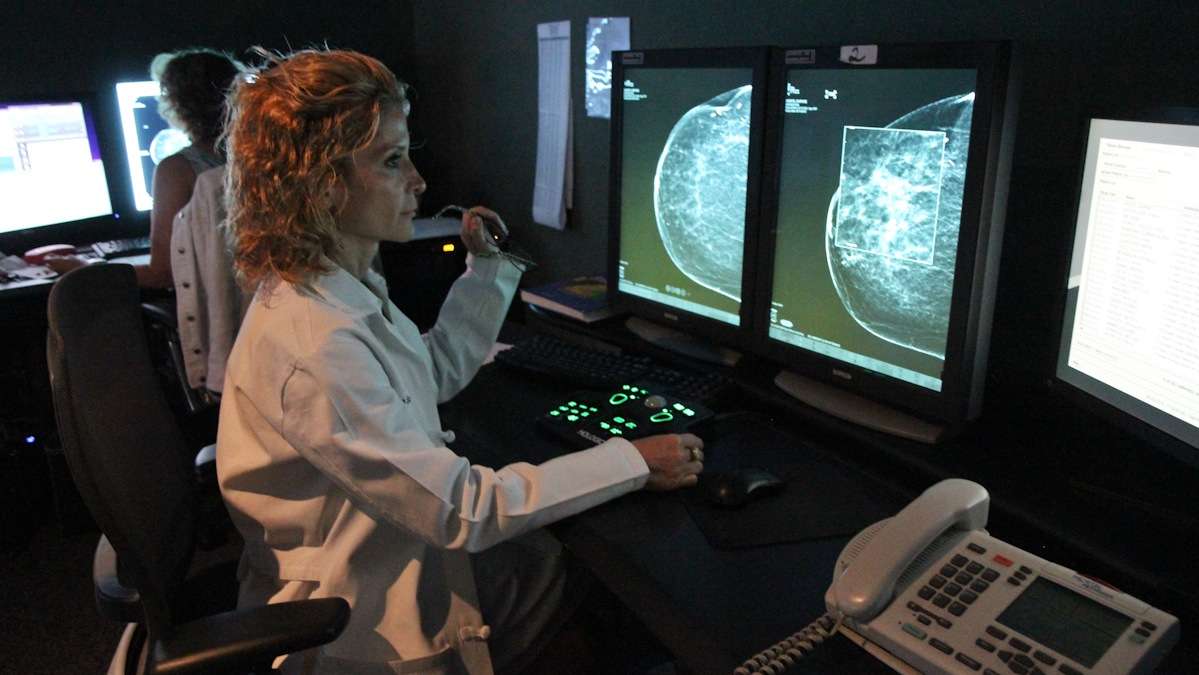Gov. Wolf says insurers in Pa. must cover 3-D mammograms

Dr. Debra Somers Copit reads mammography results in the Reading room at the Marion-Louise Saltzman Women's Center at Einstein Hospital's campus. (Kimberly Paynter/WHYY)
Insurance companies in Pennsylvania may no longer charge women extra fees for 3-D mammogram services.
In an announcement made by first lady Frances Wolf in Harrisburg on Monday, the administration clarified that the state’s policy of free mammograms also applies to the newer technology, and that both types of screening should be treated the same by insurers.
“We started hearing from consumers saying, I can’t afford to get my mammogram anymore,” said insurance commissioner Teresa Miller.
The typical added charge was $50 to $60, but according to the Pennsylvania Breast Cancer Coalition, in at least one case it was as high as $600.
Many patients are told upfront that the 3-D test will cost more, Miller said, but others have received surprise bills afterwards.
“It’s been amazing to me how many women are getting billed for mammograms when this is supposed to be a service provided at no cost to them,” she said.
President & Founder of the Pennsylvania Breast Cancer Coalition, Pat Halpin-Murphy, praised the governor for his speedy response to the problem.
“We really have to salute them for quick action on this,” she said. “It will save women a lot of money for mammograms, and more importantly, we think it will save lives.”
3-D mammography, which is also known as tomosynthesis, is not yet universally accepted. The FDA approved the technology in 2011, but as late as May of this year the U.S. Preventive Services Task Force issued draft guidelines stating there was not yet sufficient evidence to back its use.
Nevertheless, many local physicians said 3-D scans have rapidly become the standard of care.
“By having a 3-D image we can actually scroll through different layers, or slices, of the breast and the reconstructed picture so that we can unveil or unmask areas that we couldn’t see before,” said Emily Conant, a professor of radiology and the chief of breast imaging at the University of Pennsylvania.
Chief of breast imaging at the Einstein Healthcare Network, Debra Somers Copit, said the method makes it easier to detect invasive cancers and also reduces the number of false positives — two of the biggest criticisms of mammography overall.
“The best way I can put it is it’s a better mammogram,” she said. “Not a day goes by that we don’t find a cancer on the 3-D that we did not see — even retrospectively — on the 2-D.”
Copit and Conant were both authors of a 2014 study in JAMA that retrospectively analyzed nearly half a million mammograms from 13 institutions across the country. Although the results varied from clinic to clinic, 3-D scans overall appeared to increase detection without boosting the number of women falsely diagnosed.
Some 3-D screening exposes patients to a slightly higher dose of radiation than the standard digital 2-D version. But Conant noted that with improving technology, those levels are going down.
Einstein and Penn offer 3-D mammography to all patients and have never charged patients additional fees for the use of the newer equipment. Pennsylvania’s move to ensure that 3-D mammograms are free for women statewide, however, was still welcome news to both radiologists.
“It’s exciting that hopefully all women will have access to this because you hate to have it available for women at some sites only if they pay extra,” said Conant. “That just isn’t the way we want to go at all.”
WHYY is your source for fact-based, in-depth journalism and information. As a nonprofit organization, we rely on financial support from readers like you. Please give today.

